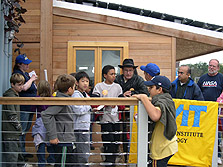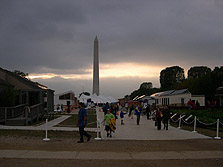

Today was School Day at the Solar Decathlon. Students learned about solar energy and energy efficiency.

Another day comes to a close here at the solar village. More points were awarded today and scores and standings are incredibly tight.
Solar Decathlon 2005
Daily Journal — October 11, 2005
If research and development (R&D) is conducted solely in a laboratory, no one benefits. Technologies must be transferred to the marketplace in order to be beneficial. That is the objective of the "Communications" contest, which was announced today.
The Communications contest challenges teams to communicate their experiences to a wide audience through Web sites and public tours. Points are awarded based on success in delivering clear and consistent messages and images that represent the vision, process, and results of each team's project. To judge this contest, a panel of Web site development experts evaluated the team Web sites remotely, while a panel of public relations experts listened to decathlete-led tours of each house.
Today, the results were announced at 10 a.m. by the panel. Here, in the panel's own words are the top three.
"The communication style of the third place winner of the Communications Contest matched the style of the house: elegant. The team members really planned how people would circulate through the home, and they have a great brochure for visitors. There will be a lot of families coming down to the competition, and the third place team is one of the only teams who made a tangible effort to reach out to children by having a tour guide pull a treat bowl off the top shelf of the kitchen and letting children pick out a small attractive recycled tile to take away. The third place award goes to Maryland.
"The team to take second place in the Communications Contest got points for easy navigation, solid and consumer-friendly content, and creative graphics on their Web site. The team members use their culture—everything from live music and artwork on the walls to emphasizing the importance of community in their culture—as an effective and appealing way of branding themselves, their mission, and their messages. Second place in the Communications Contest goes to Universidad de Puerto Rico.
"In first place is a team whose entire focus is making this house relevant to consumers. We loved that they explained Structural Insulated Panels by comparing them to an ice cream sandwich. In fact, food was a very effective branding metaphor for this team both in their house and on their Web site. The public should love the display of test tubes full of the natural and edible items that one can find in building materials and products throughout the home. The Communications Contest top award goes to the team with the house you can sink your teeth into: University of Colorado!"
Tuesday was also "school day." Hundreds of inquisitive students from area elementary and high schools visited the village and toured the houses. Special activities and handouts were prepared to make their educational field trips worthwhile. Based on the happy faces I saw I expect many of their parents to visit the village this weekend after learning about the fun day they had.
The competition is heating up. If you look at the scoring page, you will see how close the teams are to one another. In many cases, they are only 10 points or less from the team in front or behind them in the standings. Because the weather is so cloudy, the competition is also becoming more challenging. Teams who understand how to conserve energy the best are gaining points on teams who are not paying enough attention. The cloudy weather should prove more clearly who has the most energy efficient house.
In the 2002 Solar Decathlon, the house with the largest solar array won the competition, partly because it was sunny every day. When it is sunny, the house with the largest solar array has the advantage because lots of excess energy can be collected. When the weather is cloudy and no one can collect much energy, the size of the array becomes less important and efficiency becomes more important. If the weather stays cloudy it will be interesting to see who will score more points and why.
The Solar Decathlon seems to be reflecting our country's current need to conserve energy because the recent hurricanes have disrupted supply. When supplies are limited, we need to use energy more wisely.
Reporting from the village,
Richard King, Department of Energy
